1998 CADILLAC ELDORADO service
[x] Cancel search: servicePage 321 of 380
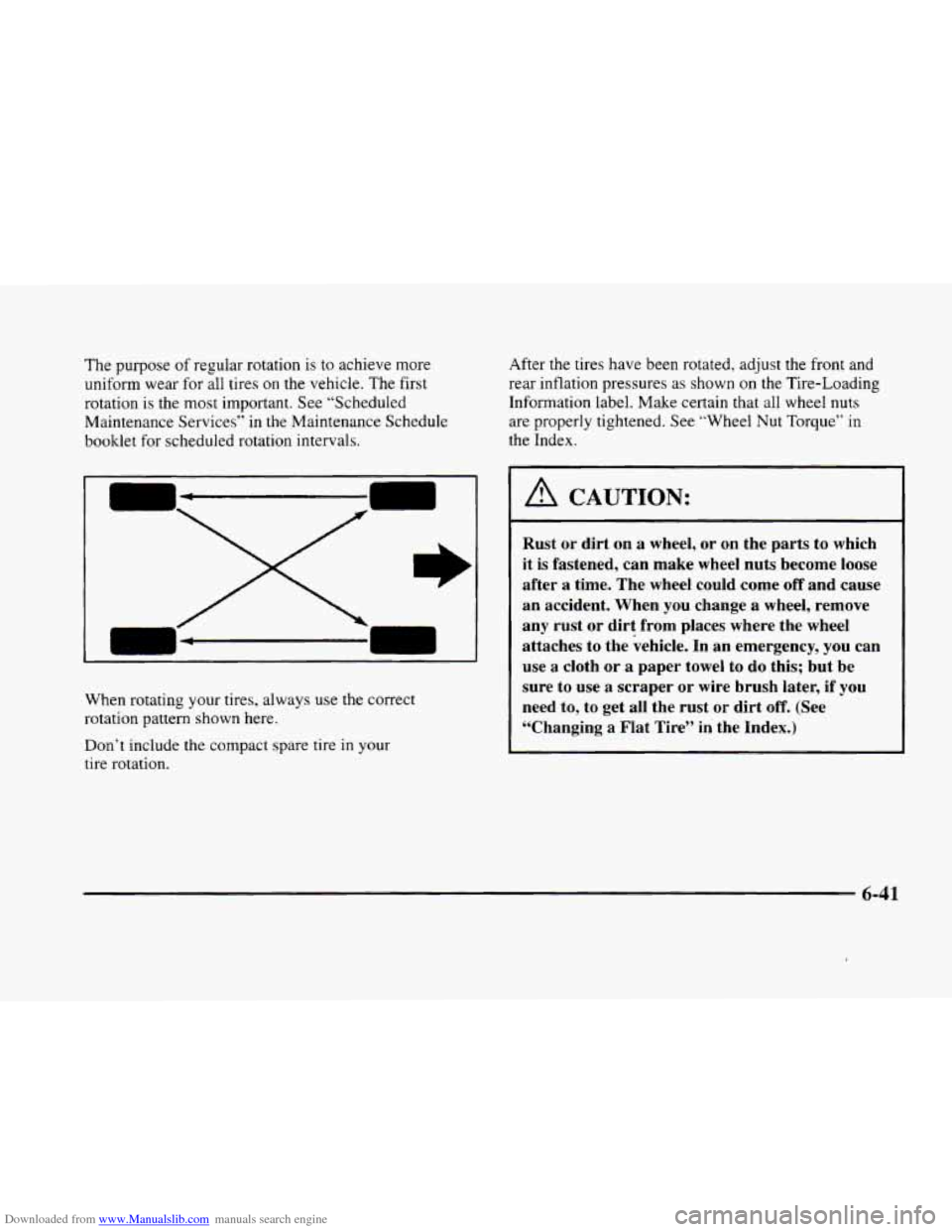
Downloaded from www.Manualslib.com manuals search engine The purpose of regular rotation is to achieve more
uniform wear for all tires
on the vehicle. The first
rotation is
the most important. See “Scheduled
Maintenance Services” in
the Maintenance Schedule
booklet for scheduled rotation intervals.
When rotating your tires, always
use the correct
rotation pattern shown here.
Don’t include the compact spare tire
in your
tire rotation. After the tires have been rotated,
adjust
the front and
rear inflation pressures as shown
on the Tire-Loading
Information label. Make certain that all wheel nuts
are properly tightened. See “Wheel Nut Torque” in
the Index.
I A CAUTION:
Rust or dirt on a wheel, or on the parts to which
it
is fastened, can make wheel nuts become loose
after a time. The wheel could come
off and cause
an accident. When you change
a wheel, remove
any rust or dirt from places where the wheel
attaches to the vehicle.
In an emergency, you can
use a cloth or a paper towel
to do this; but be
sure to use a scraper or wire brush later, if you
need to, to get all the rust or dirt
off. (See
“Changing a Flat Tire” in the Index.)
6-41
Page 322 of 380
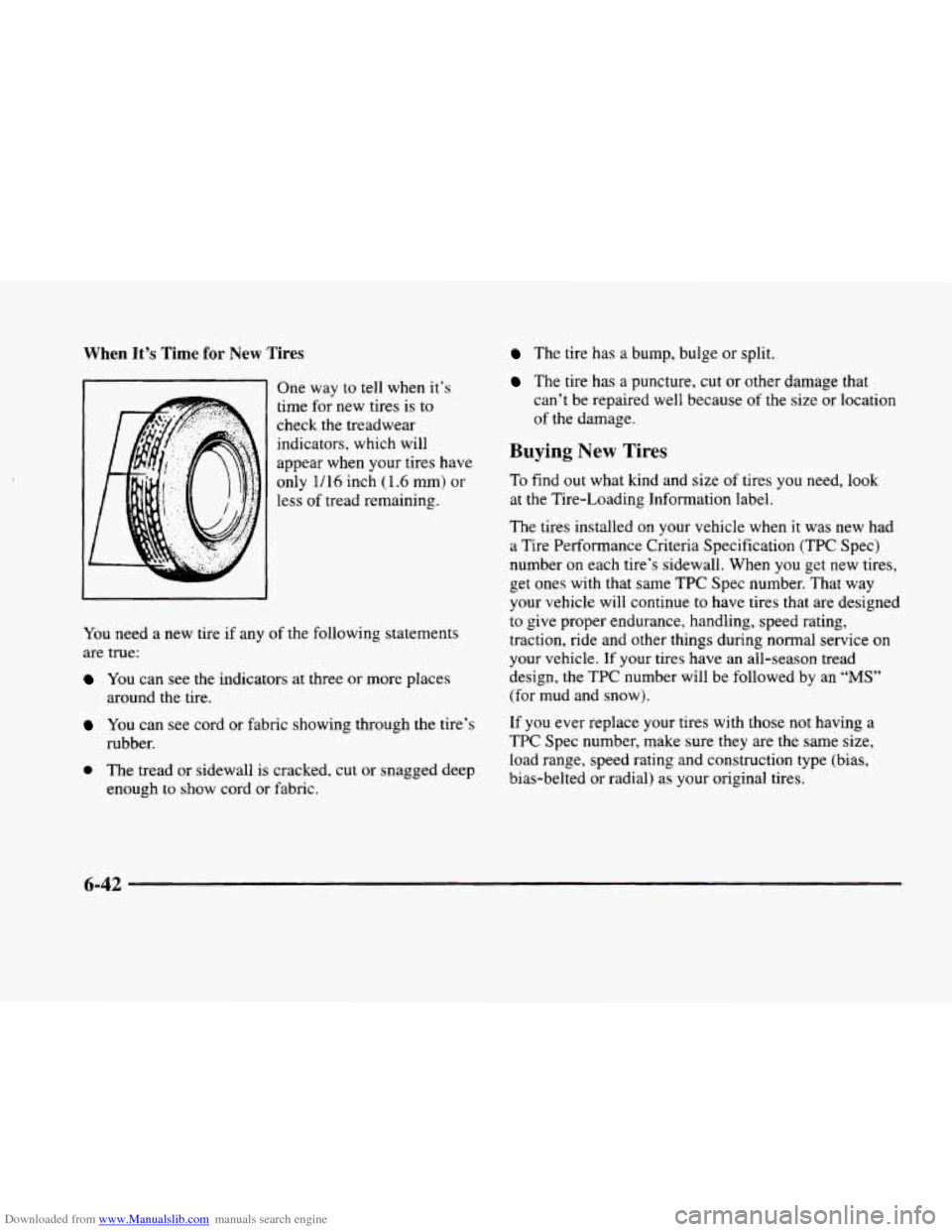
Downloaded from www.Manualslib.com manuals search engine When It’s Time for New Tires
~ One way to tell when it’s
time for new tires is to
check the treadwear
indicators, which will
appear when your tires have
only 1/16 inch (1.6 mm) or
less of tread remaining.
You need a new tire if any
of the following statements
are true:
You can see the indicators at three or more places
around the tire.
You can see cord or fabric showing through the tire’s
rubber.
The tire has a bump, bulge or split.
The tire has a puncture, cut or other damage that
can’t be repaired well because
of the size or location
of the damage.
Buying New Tires
To find out what kind and size of tires you need, look
at the Tire-Loading Information label.
The tires installed on your vehicle when
it was new had
a Tire Performance Criteria Specification (TPC Spec)
number
on each tire’s sidewall. When you get new tires,
get ones with that same
TPC Spec number. That way
your vehicle will continue to have tires that are designed
to give proper endurance, handling, speed rating,
traction, ride and other things during normal service on
your vehicle.
If your tires have an all-season tread
design, the
TPC number will be followed by an ”MS”
(for mud and snow).
If you ever replace your tires with those not having
a
TPC Spec number, make sure they are the same size,
load range, speed rating and consiruction type (bias,
0 The tread or sidewall is cracked, cut or snagged deep bias-belted or radial) as your original tires.
enough to show cord or fabric.
6-42
Page 324 of 380
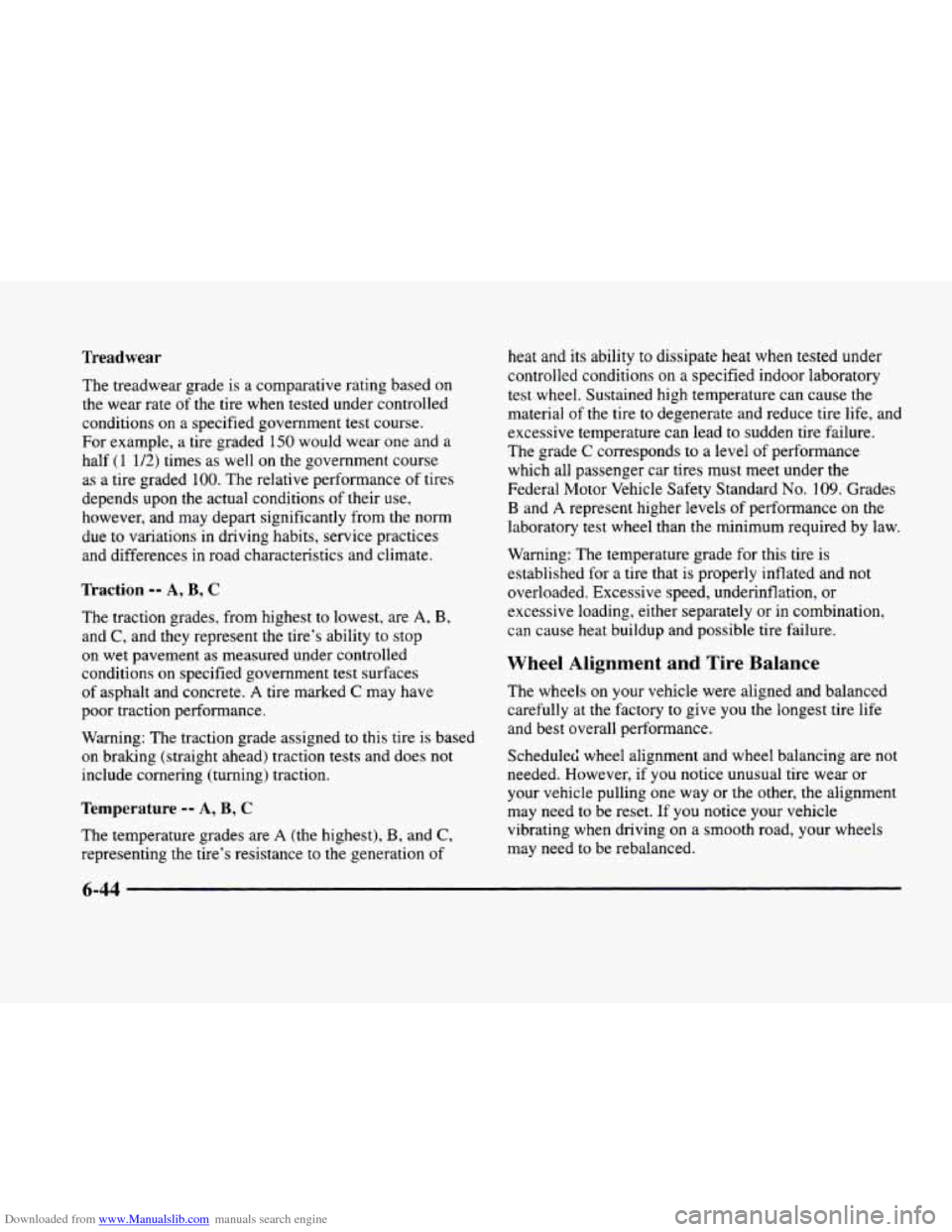
Downloaded from www.Manualslib.com manuals search engine Treadwear
The treadwear grade is a comparative rating based on
the wear rate of the tire when tested under controlled
conditions
on a specified government test course.
For example, a tire graded
150 would wear one and a
half (1 1/2) times as well on the government course
as a tire graded 100. The relative performance
of tires
depends upon the actual conditions
of their use,
however, and may depart significantly from the norm
due to variations
in driving habits, service practices
and differences in road characteristics and climate.
Traction -- A, B, C
The traction grades, from highest to lowest, are A, B,
and C, and they represent the tire’s ability to stop
on wet pavement as measured under controlled
conditions
on specified government test surfaces
of asphalt and concrete.
A tire marked C may have
poor traction performance.
Warning: The traction grade assigned to this tire is based
on braking (straight ahead) traction tests and does not
include cornering (turning) traction.
Temperature -- A, B, C
The temperature grades are A (the highest), B, and C,
representing the tire’s resistance to the generation of heat and
its ability to dissipate heat when tested under
controlled conditions on a specified indoor laboratory
test wheel. Sustained high temperature can cause the
material
of the tire to degenerate and reduce tire life, and
excessive temperature can lead
to sudden tire failure.
The grade
C corresponds to a level of performance
which all passenger car tires must meet under the
Federal Motor Vehicle Safety Standard No.
109. Grades
B and A represent higher levels of performance on the
laboratory test wheel than the minimum required by law.
Warning:
The temperature grade for this tire is
established for a tire that is properly inflated and not
overloaded. Excessive speed, underinflation, or
excessive loading, either separately
or in combination,
can cause heat buildup and possible tire failure.
Wheel Alignment and Tire Balance
The wheels on your vehicle were aligned and balanced
carefully at
the factory to give you the longest tire life
and best overall performance.
Scheduled wheel alignment and wheel balancing are not
needed. However, if you notice unusual tire wear or
your vehicle pulling one way or
the other, the alignment
may need to be reset. If
you notice your vehicle
vibrating when driving
on a smooth road, your wheels
may need to be rebalanced.
6-44
Page 332 of 380

Downloaded from www.Manualslib.com manuals search engine Cleaning Aluminum or Chrome
Wheels
(If Equipped)
Keep your wheels clean using a soft clean cloth with
mild soap and water. Rinse with clean water. After
rinsing thoroughly, dry with a
soft clean towel. A
wax may then be applied.
The surface of these wheels
is similar to the painted
surface
of your vehicle. Don’t use strong soaps,
chemicals, abrasive polishes, abrasive cleaners or
abrasive cleaning brushes on them because you could
damage the surface. You may use chrome polish on
chrome wheels, but avoid any painted surface of the
wheel, and buff off immediately after application.
Don’t take your vehicle through an automatic car wash
that has silicon carbide tire cleaning brushes. These
brushes can also damage the surface of these wheels.
Cleaning Tires
To clean your tires, use a stiff brush with a tire cleaner.
I NOTICE: I
When applying a tire dressing always take care
to wipe
off any overspray or splash from all
painted surfaces on the body or wheels
of the
vehicle. Petroleum-based products may damage
the paint finish.
Sheet Metal Damage
If your vehicle is damaged and requires sheet metal
repair or replacement, make sure the body repair shop
applies anti-corrosion material
to the parts repaired or
replaced to restore cofrosion protection.
Finish Damage
Any stone chips, fractures or deep scratches in the finish
should be repaired right away. Bare metal will corrode
quickly and may develop into a major repair expense.
Minor chips and scratches can be repaired with touch-up
materials available from your dealer
or other service
outlets. Larger areas
of finish damage can be corrected
in your dealer’s body and paint shop.
Page 335 of 380
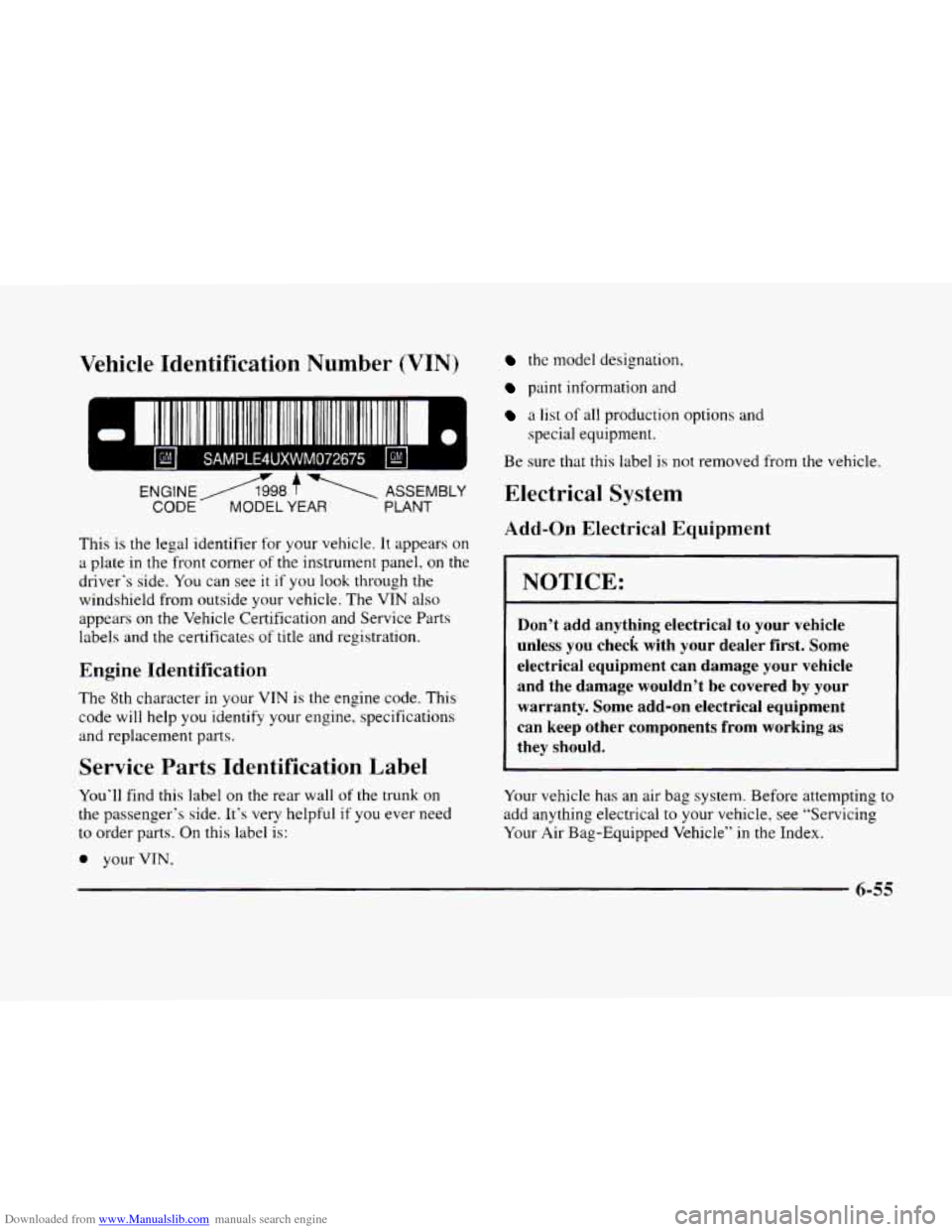
Downloaded from www.Manualslib.com manuals search engine Vehicle Identification Number (VIN)
111 1 I11111111 1111 111 111111 111 111111 II 111111111111 Ill1
SAMPLE4UXWM072675
ENGINE A98 f 1 ASSEMBLY
CODE A MODEL YEAR PLANT
This is the legal identifier for your vehicle. It appears on
a plate in the front comer of the instrument panel. on the
driver‘s side. You can see
it if you look through the
windshield from outside your vehicle. The VTN also
appears on the Vehicle Certification and Service Parts
labels and the certificates of title and registration.
Engine Identification
The 8th character in your VIN is the engine code. This
code will help you identify your engine. specifications
and replacement parts.
Service Parts Identification Label
You‘ll find this label on the rear wall of the trunk on
the passenger’s side. It’s very helpful if you ever need
to order parts.
On this label is:
0 your VIN,
the model designation,
paint information and
a list of all production options and
Be sure that this label
is not removed from
special
equipment.
Electrical System
Add-on Electrical Equipment
the vehicle.
I NOTICE:
Don’t add anything electrical to your vehicle
unless you check with your dealer first. Some
electrical equipment can damage your vehicle
and the damage wouldn’t be covered by your warranty. Some add-on electrical equipment
can keep other components
from working as
they should.
Your vehicle has an air bag system. Before attempting to
add anything electrical to your vehicle, see “Servicing
Your Air Bag-Equipped Vehicle” in the Index.
6-55
Page 336 of 380

Downloaded from www.Manualslib.com manuals search engine Headlamp Wiring
The headlamp wiring has an individual fuse which is
powered by a MaxiFuse@. An electrical overload
will cause the lamps to
go on and off, or in some
cases
to remain off. If this happens, have the headlamp
wiring checked right away.
MaxiFuse is a registered trademark
of Little
Fuse Incorporated.
Windshield Wiper Fuses
The windshield wiper motor is powered by a MaxiFuse.
If the motor overheats due to heavy snow, etc., the
wipers will stop until the
motor cools. If the overload
is caused
by some electrical problem, be sure to have
it fixed.
Power Windows and Other Power Options
Circuit breakers protect the power windows and other
power accessories. When the current load is
too heavy,
the circuit breaker opens and closes, protecting the
circuit until the problem
is fixed or goes away.
MaxiFusesmelay Center
The MaxiFuses and relays are located next to the engine
compartment fuse block
on the driver's side of the
engine. To access the compartment fuse block, remove
the shroud, cover.
If a MaxiFuse should blow, have your
vehicle serviced by your dealer immediately.
RELAY CENTER IDENTIFICATION
(WINDOWS)
RELAY
91
Page 347 of 380
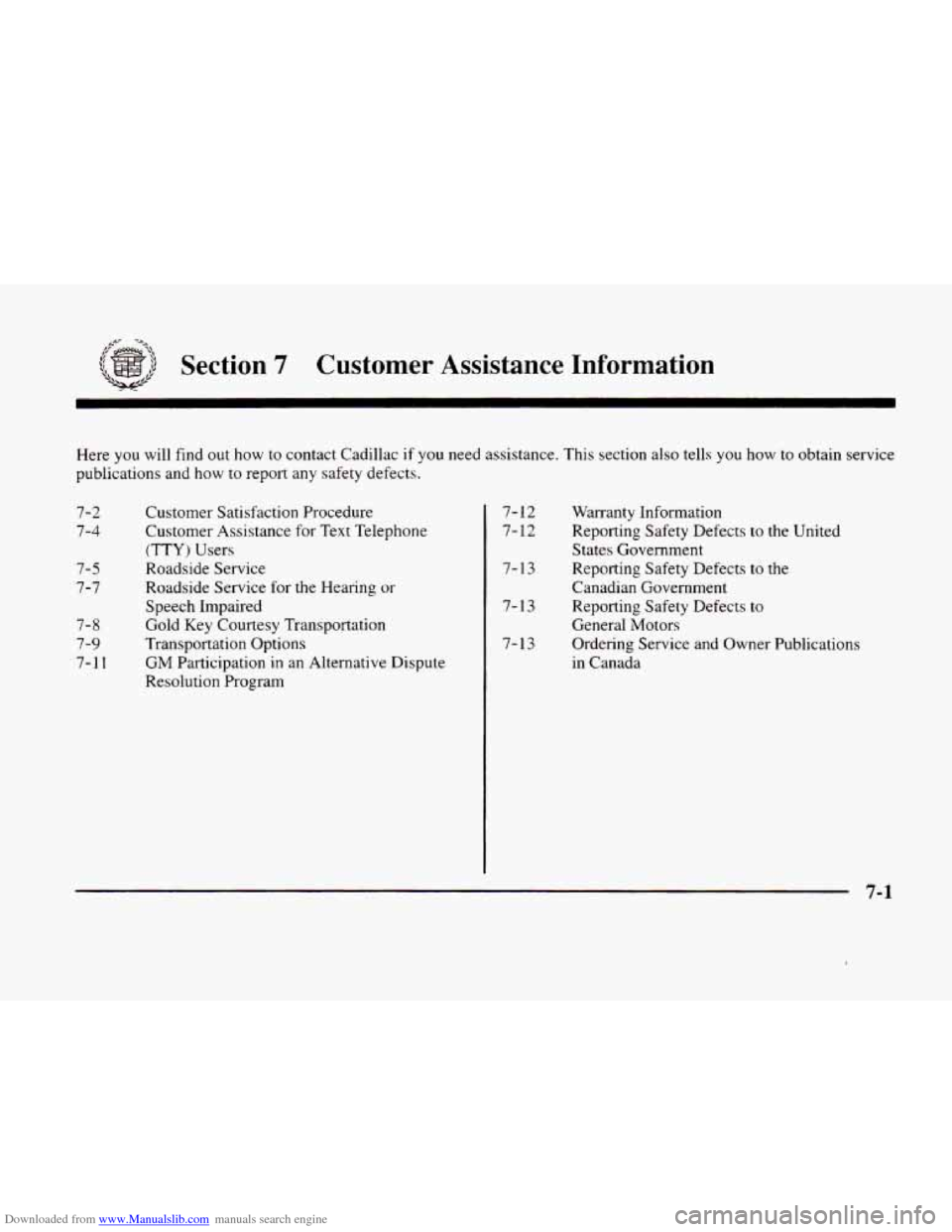
Downloaded from www.Manualslib.com manuals search engine ,/= --. .
Section 7 Customer Assistance Information
Here you will find out how to contact Cadillac if you need assistance. This section also tells you how to obtain service
publications and how
to report any safety defects.
7-2
7-4
7-5
7-7
7-8
7-9
7-1 1
Customer Satisfaction Procedure
Customer Assistance
for Text Telephone
(TTY) Users
Roadside Service
Roadside Service for the Hearing or
Speech Impaired
Gold Key Courtesy Transportation
Transportation Options
GM Participation in an Alternative Dispute
Resolution Program
7-12
7- 12
7-13
7-13
7-13 Warranty Information
Reporting Safety Defects to
the United
States Government
Reporting Safety Defects to the
Canadian Government
Reporting Safety Defects
to
General Motors
Ordering Service and Owner Publications
in Canada
7-1
Page 348 of 380
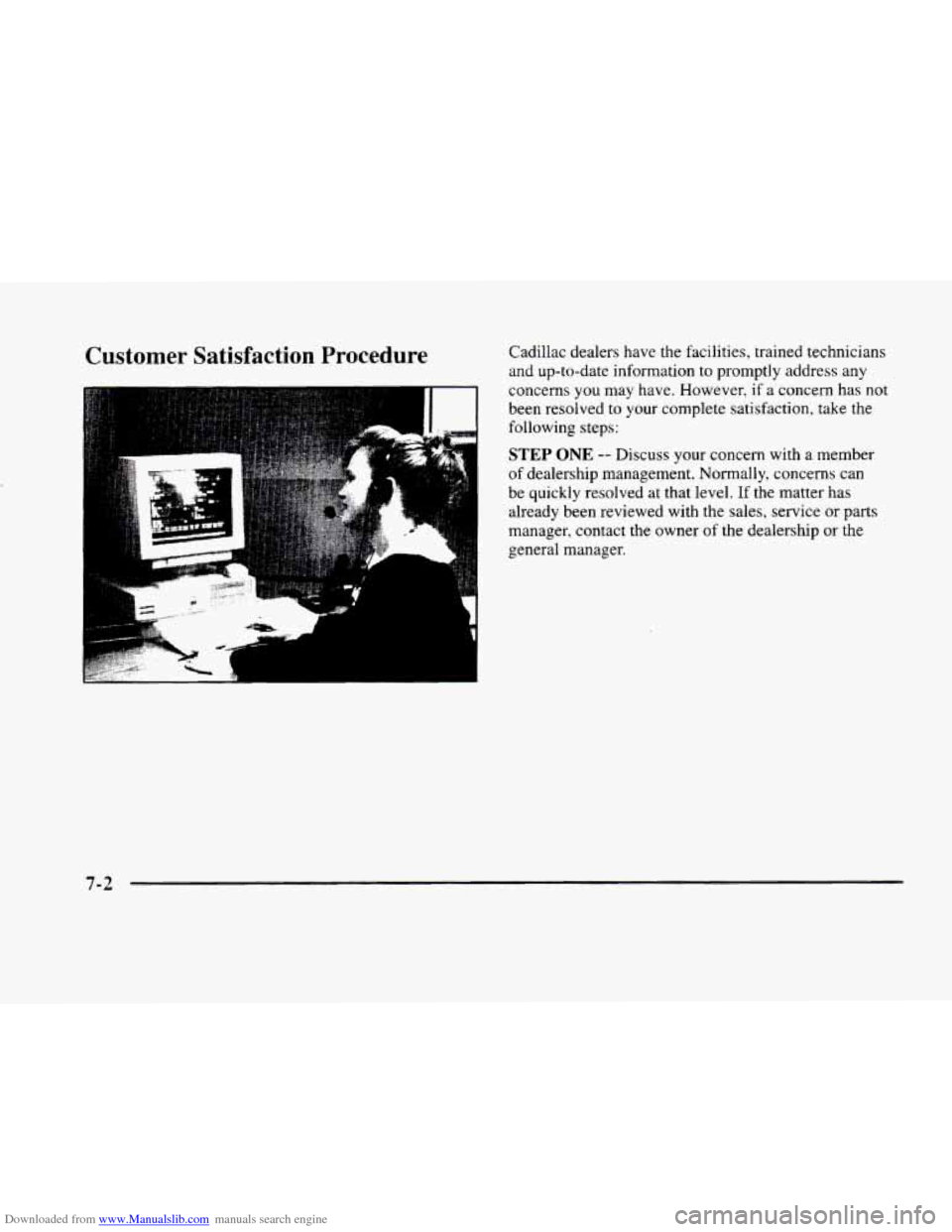
Downloaded from www.Manualslib.com manuals search engine Customer Satisfaction Procedure Cadillac dealers have the facilities, trained technicians
and up-to-date information
to promptly address any
concerns
you may have. However, if a concern has not
been resolved to your complete satisfaction, take the
following steps:
STEP ONE -- Discuss your concern with a member
of dealership management. Normally, concerns can
be quickly resolved at that level.
If the matter has
already been reviewed with the sales, service or parts
manager, contact
the owner of the dealership or the
general manager.
. .---
t
t
I
7-2